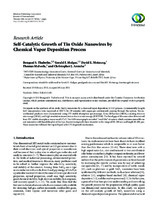| dc.contributor.author | Thabethe, Bongani | |
| dc.contributor.author | Malgas, Gerald | |
| dc.contributor.author | Motaung, David | |
| dc.contributor.author | Malwela, Thomas | |
| dc.contributor.author | Arendse, Christopher | |
| dc.date.accessioned | 2017-02-17T09:35:19Z | |
| dc.date.available | 2017-02-17T09:35:19Z | |
| dc.date.issued | 2013 | |
| dc.identifier.citation | Bongani, T. (2013). Self-Catalytic Growth of Tin Oxide Nanowires by Chemical Vapor Deposition Process. Journal of Nanomaterials, vol. 2013, Article ID 712361, 7 pages. | en_US |
| dc.identifier.issn | 1687-4110 | |
| dc.identifier.uri | http://hdl.handle.net/10566/2542 | |
| dc.identifier.uri | http://dx.doi.org/10.1155/2013/712361 | |
| dc.description.abstract | We report on the synthesis of tin oxide (SnO2) nanowires by a chemical vapor deposition (CVD) process. Commercially bought
SnO nanopowders were vaporized at 1050∘C for 30 minutes with argon gas continuously passing through the system. The assynthesized
products were characterized using UV-visible absorption spectroscopy, X-ray diffraction (XRD), scanning electron
microscopy (SEM), and high-resolution transmission electron microscopy (HRTEM). The band gap of the nanowires determined
from UV-visible absorption was around 3.7 eV.The SEM micrographs revealed “wool-like” structure which contains nanoribbons
and nanowires with liquid droplets at the tips. Nanowires typically have diameter in the range of 50–200nm and length 10–100 𝜇m.
These nanowires followed the vapor-liquid-solid (VLS) growth mechanism. | en_US |
| dc.language.iso | en | |
| dc.publisher | Hindawi | en_US |
| dc.rights | All articles published in Hindawi journals are available to readers completely free of charge. | |
| dc.subject | Self-Catalytic | en_US |
| dc.subject | Tin Oxide | en_US |
| dc.subject | Nanowires | en_US |
| dc.subject | Deposition Process | en_US |
| dc.title | Self-catalytic growth of tin oxide nanowires by chemical vapor deposition process | |
| dc.type | Article | en_US |
| dc.privacy.showsubmitter | FALSE | |
| dc.status.ispeerreviewed | TRUE | |

